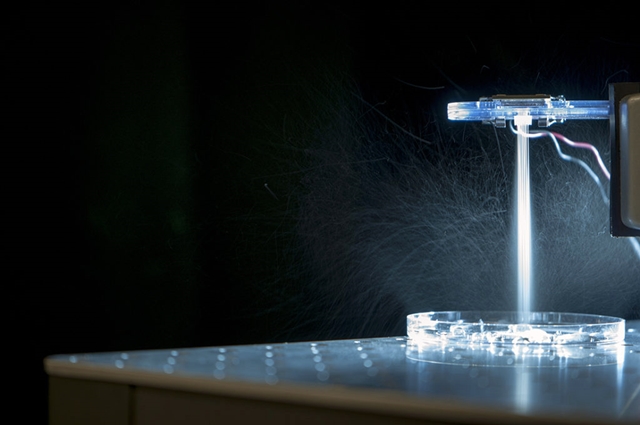
Acoustic shear poration device, top, spraying cells in dish below. (Washington University in St. Louis)
28 February 2018. An engineering team at Washington University in St. Louis is developing mechanical and electronic processes to improve the success of inserting large, complex therapeutic molecules like DNA into cells. A team from the lab of mechanical engineering professor Mark Meacham, with colleagues from Georgia Institute of Technology and the company OpenCell Technologies, describes its process in yesterday’s issue of the journal Scientific Reports.
New types of treatments for disease are emerging that take healthy, edited, or modified genetic material such as DNA and insert those molecules into cells. For example, treatments for some types of leukemia were approved by FDA that take a patient’s T-cells from the immune system and modify the cells to express proteins that kill cancer cells. Other therapies in development edit out disease-causing mutations from DNA and insert them back into a patient’s cells or stem cells.
While these developments are promising, the process for transferring genes to cells remains difficult and error prone. Meacham and colleagues at Washington University are seeking more reliable methods for these transfers between cells, making them easier to perform and less likely to fail. Their solution should apply as well to other large complex molecules, such as RNA, proteins, and nanoparticles.
“For such methods to be successful,” says Meacham in a university statement, “pores must be created in the cell membrane that are large enough and stay open long enough to insert molecules while not damaging or killing the cell and delivering the molecule to the cell’s nucleus where it can work.”
The researchers’ solution combines mechanical forces on cell membranes with electronic techniques. Mechanical forces in the process are generated with ultrasound — high frequency sound waves — in a method called acoustical shear poration. Ultrasound spray nozzles create shear forces on cells with fluids that make temporary openings in their membranes of 100 to 150 nanometers in size, enabling larger molecules to pass through. But the pores also close up about a minute after the ultrasound waves stop.
Coupled with the mechanical forces is an electric field produced by a method called electrophoresis. This technique is used in labs to separate larger molecules like nucleic acids — e.g., DNA and RNA — and proteins and move them through matrices. In this case, the electric field moves larger molecules and nanoscale materials through the temporary openings in cell membranes created with acoustical shear poration.
Proof-of-concept tests with cell lines and T-cells — white blood cells from the immune system — in the lab show acoustical shear poration enables openings in cells large enough to deliver non-gene materials, increasing their delivery success by more than 75 percent. Further testing shows the combined mechanical and electric process successfully delivers DNA plasmid molecules, like those in bacteria, to the target cells.
Meacham began his research on intercellular delivery technologies as a graduate student at Georgia Tech in Atlanta, where he and colleagues co-founded the company OpenCell Technologies that licenses intellectual property for the process. OpenCell Technologies is developing a technique called Poros for delivery of large molecules like proteins and nanoparticles to cells, and since relocated to St. Louis.
More from Science and Enterprise:
- Patents Awarded for Genetic Editing of CAR T-Cells
- Stem Cells Created with Gene Editing
- Sangamo, Pfizer Partner on ALS Gene Therapy
- RNA Therapies Start-Up Raises $55.3M in Early Funds
- FDA Approves Gene Therapy for Inherited Vision Loss
* * *

 RSS - Posts
RSS - Posts
You must be logged in to post a comment.